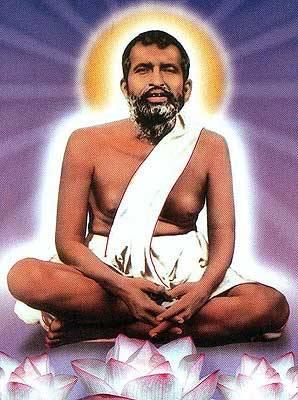World Thinkers on
Ramakrishna Paramhansa
by Chander M. Bhat
Sri Ramakrishna and Vivekananda represent one single truth, one
 its spirit
and the other its form. Sri Ramakrishna Paramahansa’s life itself is his
message. As Swami Vivekananda, his great disciple, said: “He was contented
simply to live the great life and to leave it to others to find the
explanation.” its spirit
and the other its form. Sri Ramakrishna Paramahansa’s life itself is his
message. As Swami Vivekananda, his great disciple, said: “He was contented
simply to live the great life and to leave it to others to find the
explanation.”
Inspite of the Swami Vivekananda reticence in
preaching missions in the East and the West, and by establishing the Ramakrishna
Math and the Ramakrishna Mission to serve the world through spiritual teachings
and also through he alleviation of suffering. Sri Ramakrishna Paramahansa became
known to some leading minds in the West even within a few years of his passing.
In India, on the other hand, some of the elite as well as other educated people
had been attracted to him during his lifetime.
In the West the first noteworthy recognition of the greatness of Sri Ramakrishna
and his message came from Professor Max Muller, the well-known Oriental scholar.
Professor Max Muller, while introducing Sri Ramakrishna said, “If we remember
that these utterances of Ramakrishana reveal to us not only his own thoughts,
but the faith and hope of millions of human beings, we may indeed feel hopeful
about the future of that country. The consciousness of the Divine in man is
there and shared by all, even by those who seem to worship idols. This constant
sense of the presence of God is indeed the common ground on which we may hope
that in time not too distant, the great temple of the future will be erected, in
which Hindus may join hands and hearts in worshipping the same supreme
spirit…….who is not far from every one of us for in Him we live and move and
have our being.” Sri Aurobindo, who started as a nationalist revolutionary, but
later became the celebrated yogi of Pondicherry, wrote about Sri Ramakrishna,
“Sri Ramakrishna represented a synthesis in one person of all the leaders. It
follows that the movement of his age will unify and organize the more provincial
and fragmentary movements of the past. Ramakrishna is the epitome of the whole.
His was the superconscious life, which alone can witness to the infinitude of
the current that bears us all oceanwards. He is the proof of the power behind
us, and the future before us. So a great birth initiates great happenings.”
Romain Rolland, the French savant, felt attracted to Ramakrishna, he says, “The
man whose image I here evoke was the consummation of two thousand years of the
spiritual life of three hundred million people. Although he has been dead forty
years, his soul animates modern India. He was no here of action like Gandhi, no
genius in art of thought like Goethe or Tagore. He was a little village Brahman
of Bengal, whose outer life was set in a limited frame without striking
incident, outside the political and social activities of his time. But his inner
life embraced the whole multiplicity of men and Gods.”
Christopher Isherwood, noted man of letters in the West, writes about Sri
Ramakrishna, Tthis is the story of phenomenon. A phenomenon is often something
extraordinary and mysterious. Ramakrishna was extraordinary and mysterious; most
of all to those who were best fitted to understand him. A phenomenon is always a
fact, an object of experience. That is how I shall try to approach Ramakrishan.”
Arnold J. Toynbee, a German philosopher writes, “Ramakrishna’s message was
unique in being expressed in action……..Religion is not just a matter of study,
it is something that has to be experienced and to be lived, and this is the
field in which Ramakrishna manifested his uniqueness……..His religious activity,
and experience were, in fact, comprehensive to a degree that had perhaps never
before been attained by any other religious genius in India or elsewhere.”
Alexander Shifman, Adviser to the Tolstoy State Museum, in his book Tolstoy and
Indian writes: ‘During the last decade of Tolstoy’s life Ramakrishna and his
pupil Vivekananda occupied his thoughts…….’ ‘On 13 February 1903, Tolstoy read
the journal Theosophischer Wegweister sent to him from Germany and in his copy
underlined a number of Ramakrishna’s aphorisms. “There is much in common with my
conception”- he noted in his diary’.
S. Radhakrishnan, Philosopher President of India writes, “While the saying of
Sri Ramakrishna did not penetrate so mush into academic circles, thy found their
way into lonely hearts who have been stranded in their pursuit of pleasure and
selfish desires. Under the inspiration of this great teacher there has been a
powerful revival of social compassion…..He has helped to raise from the dust the
fallen standard of Hinduism, not in words merely, but in works also.”
| 